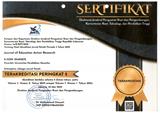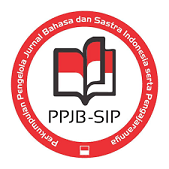VARIASI MENGAJAR GURU BAHASA INDONESIA DI KELAS VIII SMP N 2 SAWAN
DOI:
https://doi.org/10.23887/jjpbs.v5i3.8691Abstract
Penelitian ini bertujuan (1) mendeskripsikan variasi mengajar guru Bahasa Indonesia di kelas VIII SMP N 2 Sawan, (2) mendeskripsikan hambatan-hambatan yang dialami guru Bahasa Indonesia dalam mengadakan variasi mengajar di kelas VIII SMP N 2 Sawan, (3) mendeskripsikan usaha guru Bahasa Indonesia dalam mengatasi masalah yang dihadapi ketika mengadakan variasi mengajar di kelas VIII SMP N 2 Sawan. Penelitian ini menggunakan rancangan deskriptif kualitatif. Subjek dalam penelitian ini adalah guru Bahasa Indonesia di kelas VIII SMP N 2 Sawan. Objek penelitian ini adalah keterampilan mengadakan variasi mengajar oleh guru Bahasa Indonesia. Metode pengumpulan data yang digunakan dalam penelitian ini adalah metode observasi dan metode wawancara. Penelitian ini menggunakan teknik analisis deskriptif kualitatif. Data dianalisis dengan langkah sebagai berikut: identifikasi data, klasifikasi data, penyajian data, verifikasi dan penarikan simpulan. Hasil penelitian ini menunjukkan bahwa ada beberapa hal yang menonjol terkait dengan masalah yang diangkat, yakni: (1) variasi mengajar guru yang meliputi gaya mengajar, hal yang paling menonjol adalah perubahan posisi. Variasi penggunaaan media dan bahan ajar yang paling menonjol adalah variasi media pandang. Variasi pola interaksi yang paling menonjol adalah pola interaksi satu arah. (2) Hambatan yang paling menonjol dalam mengadakan variasi mengajar adalah pola interaksi. (3) Usaha yang paling dilakukan guru dalam mengatasi masalah adalah mengadakan diskusi kelompok.Kata Kunci : variasi mengajar, pembelajaran bahasa Indonesia
The aims of this descriptive study are (1) describe the variation of teaching Indonesian teacher in class VIII SMP N 2 Sawan, (2) describe the barriers experienced by Indonesian teachers in performing variations of teaching in class VIII SMP N 2 Sawan, (3) describe the effort of teachers Indonesian in addressing the problems faced when holding variation teach in grade VIII SMP N 2 Sawan. This study used a qualitative descriptive design. Subjects in this study is the Indonesian teachers in class VIII SMP N 2 Sawan. The object of this research is a skill taught by teachers holding variation Indonesian. Data collection methods used in this research is the method of observation and interview methods. this study used a qualitative descriptive analysis techniqiues. Data were analyzed with the following steps: data identification, classification, data presentation, verification and drawing conclusions. The results of this study indicate that there are some things that stand related to the issues raised, namely: (1) variations in the teacher's teaching includes teaching styles, the most outstanding thing is the change in position. Variations in the use of media and teaching materials is the most prominent media variation of view. Variation patterns of interaction is the most prominent one-way interaction patterns. (2) the most prominent obstacle in organizing the teaching of variation is the pattern of interaction. (3) The most prominent teachers do to overcome the problem is to have a group discussion.
keyword : variation of teaching, learning Indonesian
Published
2016-11-02
Issue
Section
Articles
License
Authors who publish with the Jurnal Pendidikan Bahasa dan Sastra Indonesia Undiksha agree to the following terms:- Authors retain copyright and grant the journal the right of first publication with the work simultaneously licensed under a Creative Commons Attribution License (CC BY-SA 4.0) that allows others to share the work with an acknowledgment of the work's authorship and initial publication in this journal
- Authors are able to enter into separate, additional contractual arrangements for the non-exclusive distribution of the journal's published version of the work (e.g., post it to an institutional repository or publish it in a book), with an acknowledgment of its initial publication in this journal.
- Authors are permitted and encouraged to post their work online (e.g., in institutional repositories or on their website) prior to and during the submission process, as it can lead to productive exchanges, as well as earlier and greater citation of published work. (See The Effect of Open Access)







